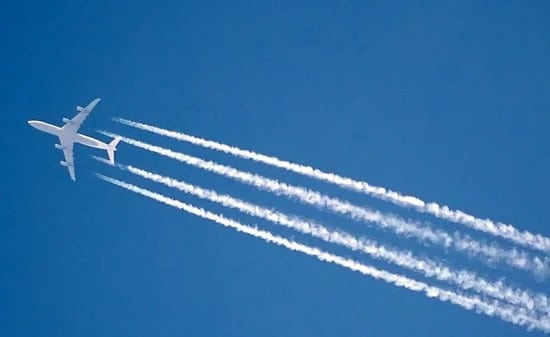UAE’s Etihad Airways signed a multi-year deal with UK-based SATAVIA to use advanced data analytics for vapor trail prevention in its daily flight operations.
Etihad will use SATAVIA’s specialized software to optimize flight paths and minimize vapor trails. Etihad had previously run a pilot project to reduce vapor trails on transatlantic flights. The latest partnership with SATAVIA will expand this beyond the demonstration stage.
This could also lead to more partnerships around generating carbon credits from vapor trail management. The generation of the vapor trail avoidance credits will be based on SATAVIA’s climate impact analysis.
What are Vapor Trails?
When flying at high altitudes, aircrafts form white, cloud-like trails behind the body of the plane.


These trails are actually made up of tiny ice crystals that occur due to condensation. These form under specific atmospheric conditions and like CO2, contribute to the earth’s greenhouse effect.
In addition to CO2 emissions, jet engines also emit water vapor from fuel combustion. At very high cruising altitudes (around 8000 m or 26,000 ft), the air outside is quite cold.
This means that the water vapor will condense quickly when they encounter this cold external air. The water vapor could be from the engine’s exhaust gases or from the ambient air when the relative humidity is high.
This condensation occurs on dust or sulfur particles that are also emitted from the aircraft. The end result is tiny ice crystals that form cirrus clouds.
The duration of the vapor trail has a huge impact on its global warming effect. Some vapor trails disperse quickly and are not problematic for the climate. However, if the relative humidity is over 100%, the vapor trails are more persistent and last for hours. These will trap heat and contribute to the greenhouse effect.
Vapor Trail Management in Aviation
In recent years, vapor trails have become a huge issue for the aviation industry. Some research has shown that they can contribute even more towards global warming than CO2.
One 2018 study looked at the contribution of the aviation sector towards climate change between 2000 and 2018. It found that vapor trails were responsible for almost 60% of aviation’s effect on climate change.
Vapor Trails management in aviation requires a multi-aspect approach. Firstly, engine efficiencies would need to be improved, so that they emit fewer sulfur or dust particles. This leaves less room for condensation.
The other strategy is to optimize flight paths so that the flights do not encounter the atmospheric conditions that form vapor trails. For example, minimizing flight paths encountering high relative humidity or avoiding areas that have lots of dust particles in the air.
SATAVIA’s Vapor Trail Management System
SATAVIA is a UK-based data analytics startup founded by volcanologist Adam Durant. Durant has extensive experience studying the links between atmospheric conditions and aircraft function.
After seeing the aviation industry disrupted by a volcanic eruption in Iceland in 2010, it motivated Durant started his company in 2013. According to Durant, only 5-10% of flights are responsible for 80-90% of vapor trails. Hence, optimizing only a few flight paths could significantly reduce climate impact.
SATAVIA provides a specialized management program to predict vapor trail formation. It uses real-time satellite imagery and atmospheric conditions like temperature and humidity to make accurate predictions. The prediction model could be used up to 36 hours in advance.
SATAVIA vapor trail prevention deal with Etihad will allow the latter to leverage those technologies.
Etihad’s Commitment to Greener Aviation
This is one of Etihad’s many projects to tackle climate change in the aviation industry. In 2022, the company marked Earth Day by carrying out 42 EcoFlights in five days. This included 22 vapor trail management flights.
Based on the results from the EcoFlights, the company said they saved 40 minutes of flight time and reduced six tonnes of carbon emissions. And for each ton of CO2 reduced, Etihad gets one carbon credit. The airline is trading its vapor trail avoidance credits on a carbon exchange platform.
The flights tested a number of optimization strategies. These included:
- Optimized flight paths to reduce fuel consumption and carbon emissions
- Vapor Trails prevention to reduce water vapor emissions
- Variable cruising speed using specialized software. Etihad claims this translated to 15% fuel savings.
- Reduced flaps for landing, which reduces drag and fuel consumption. Etihad claims this saves 30 kgs of fuel for every approach.
- Using a single-engine to taxi. Shutting down one engine during taxiing resulted in a 20%-40% saving in carbon emissions, according to the company.
The data collected from these flights would be valuable to optimize future flight paths and other green aviation initiatives. Apart from its Satavia vapor trail deal, Etihad also has established the Greenliner and Sustainable50 programs to achieve its decarbonization goals. These programs were in collaboration with Boeing, GE and Rolls Royce.
The aviation industry has multiple programs in place to bring down emissions. Initiatives such as carbon-offsetting CORSIA, are a major step towards reaching net zero by 2050. However, some major airlines like EasyJet and JetBlue are moving away from carbon offsetting and towards using Sustainable Aviation Fuels (SAFs).
- SEO Powered Content & PR Distribution. Get Amplified Today.
- Platoblockchain. Web3 Metaverse Intelligence. Knowledge Amplified. Access Here.
- Source: https://carboncredits.com/eitihad-and-satavia-vapor-trails/